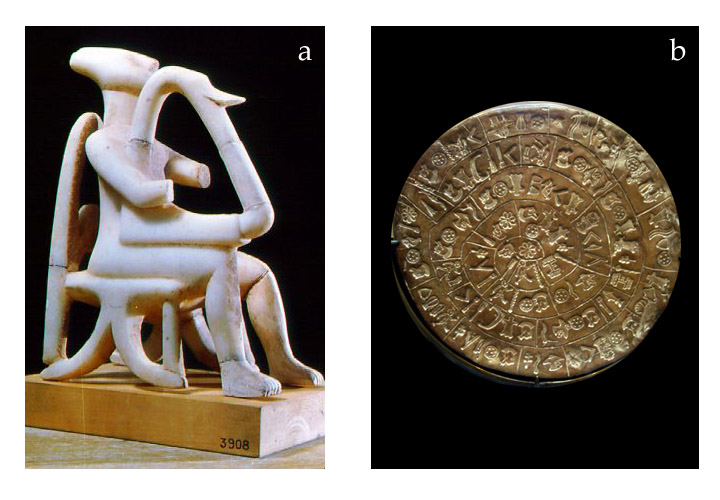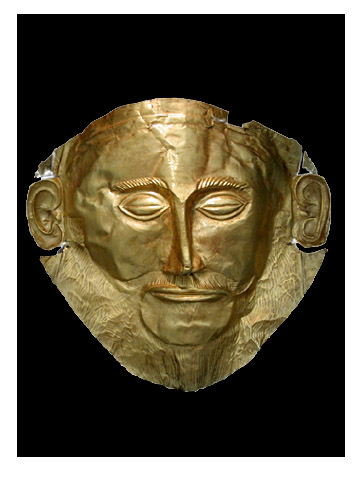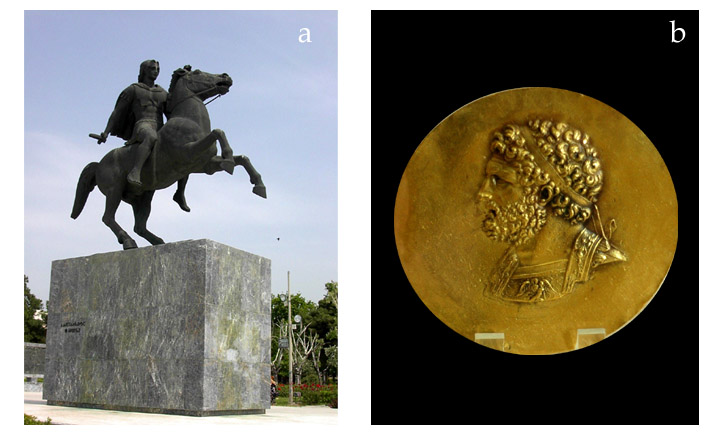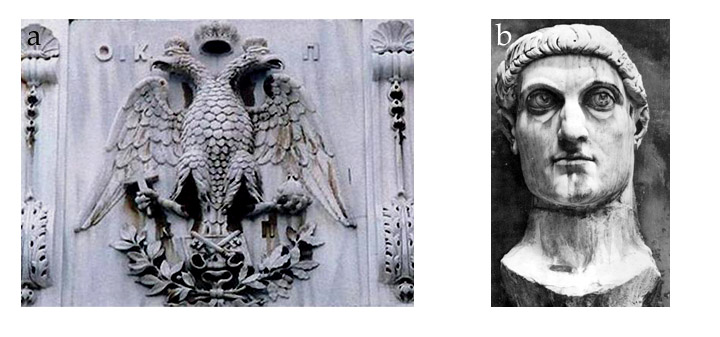
(a) Cycladic idol portraying a harp player. (b) The disc of Phaistos with the unknown syllabic signs.
Prehistory of Hellas
The dawn of civilization on the Helladic grounds dates back to roughly 3000 BC, that is 5000 years from today! The term “Aegean civilization” collectively describes the Bronze Age civilizations of continental Hellas and the islands of the Aegean Sea. Archaeological findings reveal that three distinct cultural trails were simultaneously developed in prehistoric Hellas. The Cycladic civilization was developed in Cyclades during the Cycladic Period (3000-2000 BC) and is best known for the schematic white marble idols, often used as offerings to the dead.

(a) Cycladic idol portraying a harp player. (b) The disc of Phaistos with the unknown syllabic signs.
Furthermore, the Minoan civilization flourished in the island of Crete (3650-1100 BC) and greatly influenced the Mycenaean culture by which it was eventually superseded. The Minoan civilization, named after King Minoas, is best known for the monumental palaces of Knossos and Phaistos as well as some symbolic objects, like the double axe and the bull horns which seem to have had religious meaning for Minoans. The Disc of Phaistos, a circular plate engraved with unknown syllabic signs, remains an incomprehensible riddle waiting to be deciphered. Finally, the culture of mainland Hellas was developed over the Helladic period (2800 - 1000 BC) and culminated in the flourishing of the Mycenaean civilization which is associated with the name of King Agamemnon and the epic Trojan War, described in Iliad by Homer. |
 Gold Mycenean funeral mask believed to belong to Agamemnon. |
Ancient Hellas (1100 – 146 BC)
The end of the Mycenaean civilization and the subsequent dawn of Ancient Hellas were brought about by the invasion of the Dorian tribes from the north, north-eastern regions of Greece, ancient Macedonia and Epirus, to Attica and the Peloponnesus, certain Aegean islands, and to the coast of Asia Minor. The Dorians constitute one of the ancient Hellenic tribes named after the mythological person Dorus, son of Hellen. Hellen (Έλλην ) should not be confused with Helen of Troy, but is the son of Deucalion and Pyrrha, the only surviving pair of humans after the Great Deluge imposed by Zeus to destroy Bronze Age.
Archaeologists divide the history of Ancient Hellas to four periods: the Greek Dark Ages (1100 - 800 BC) is characterized by geometrical schemes such as squares, circles, lines for the decoration of pottery.
The Archaic Period (800 - 500 BC) is best known for larger free-standing sculptures in firm poses with the dreamlike “archaic smile”.
During the Classical Period (500–323 BC) the artists perfected the “classical” style and created miraculous artifacts and monuments such as the Parthenon. Further achievements, such as the establishment of the world’s first democracy by Cleisthenes (Athens 500 BC) and the profound development of letters and philosophy, designate Hellas as the birthplace of Modern Western Civilization. During the Persian Wars (490 BC Darius I, 480 BC Xerxes I) the Hellenes battled successfully against the Persians; however, conflicts between the two dominant powers Athens and Sparta resulted in the Peloponnesian War (431 BC) which led to the devitalization of the two powers and the rise of Macedon.

(a) The Parthenon, an architectural monument of unsurpassed perfection. (b) Perikles, a prominent political figure of Athens in the 5th century BC.
Phillip, the King of Macedon (382-336 BC) created a federation of Hellenic states the so called “League of Corinth” (338/337 BC) with the intention to use the Hellenic military forces to declare war to Persia. Phillip was assassinated (336 BC) before putting his plan into action and thus the invasion of Persia was realized by his son Alexander the Great. Alexander the Great conquered a large portion of the world known at that time but showed a great respect for the cultural elements of the people he confronted. The vast empire he created started disintegrating soon after his death (323 BC), leading to the Hellenistic Period.

(a) The sculpture of Alexander the Great in Thessaloniki. (b) King Phillip the father of Alexander the Great.
In the subsequent Hellenistic years (323-146 BC), also known as Alexandrian years, aspects of Hellenic civilization expanded to Egypt and Bactria. The main cultural centers expanded from mainland Greece, to Pergamon, Rhodes, Antioch and Alexandria; however, the invasion of the Romans (146 BC) marked the end of Hellenic political independence.
Roman Hellas (146 BC - 330 AD)
Roman Hellas is the period following the Roman victory over the Corinthians (146 BC) until the reestablishment of the city of Byzantium by Constantine I (330 AD). Even though Hellenic political independence was a glory of the past, the roman rule did not break the continuity of Hellenistic society and culture, which remained essentially unchanged until the advent of Christianity (330 AD). As Horace said, “Graecia capta ferum victorem cepit” (“Captive Greece conquered her savage victor”).
Medieval Hellas (330-1831 AD)
Two great empires ruled during the Middle Ages: the Byzantine Empire (330-1453 AD) and the Ottoman Empire (1453-1821AD).
The Byzantine Empire is the term conventionally used since the 19th century to describe the Greek-speaking Roman Empire of the Middle Ages. When Constantine I inaugurated the city of Byzantium as the new capital of the Roman Empire and renamed the city to Constantinople, the process of further Hellenization and increasing Christianization was already under way. Byzantium, initially a multi-cultural empire, adopted the new religion and emerged as a Hellenic-Christian empire, shaping at a great extend the contemporary Hellenic culture. After the invasion of Constantinople by the Crusaders (1204 AD) the Byzantine Empire started losing power and come to an end with the sacking of Constantinople by the Ottoman Turks (1453 AD).
 (a) The byzantine double-faced eagle, emblem of the Paleologus dynasty. (b) Constantine I.
(a) The byzantine double-faced eagle, emblem of the Paleologus dynasty. (b) Constantine I.
The Ottoman Empire ruled Greece from 1453 AD to 1821 AD when the Hellenic Revolution broke out. The Ottoman rule tolerated the Christian faith and thus Hellenes were able to keep their cultural identity; however, during these 400 years of slavery Hellas lost the chance to keep up with cultural streams of that Era such as the Renaissance. Finally, the Hellenic Revolution (War of Independence, 1821-1831 AD) was the initiation of the falling of the Ottoman rule in Hellas.
Modern Hellas (1832 AD - today)
Ioannis Kapodistrias was the first Head of the Hellenic State but before Hellas attained international recognition he was assassinated (1831 AD). At the London Conference of 1832, the Great Powers at the time, Great Britain, France and Russia offered the throne to the 17-year-old Bavarian Prince Otto who became the first King of Modern Hellas. After an uprising on September 3, 1843 AD, Otto was forced to grant Greece a constitution thereby becoming a constitutional monarch until he was deposed in 1863 AD. Hellas was ruled by subsequent monarchs until the German invasion in 1941 AD which established German rule until 1944 AD when King George II undertook the throne. Monarchy was overthrown with the advent of the Greek Military Junta (1967 AD). The “Regime of the Colonels” ended in 1974 AD after the uprising at the Polytechnic School of Athens (17 Nov 1973 AD) and the invasion of Turkish forces in the northern part of Cyprus (20 July 1974 AD). From 1974 AD until today Hellas has been a republic.
The material was largely drawn upon the wikipedia lemmas. For more information please visit
http://en.wikipedia.org/wiki/History_of_Greece
Designed by Michail Stamatakis (mstam@rice.edu), Rice University, 31 December 2005
Updated 02 September 2006